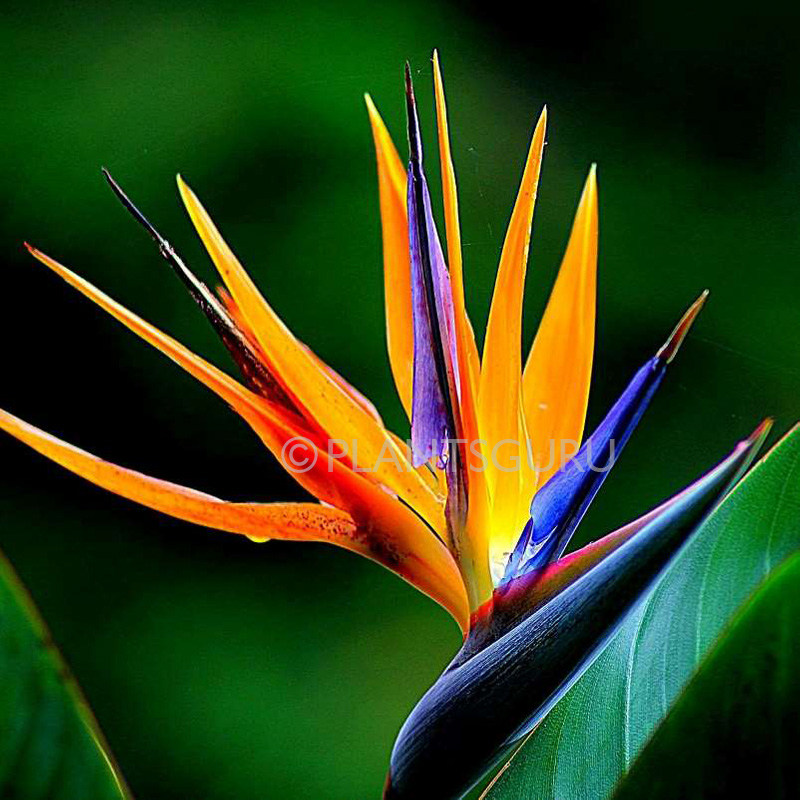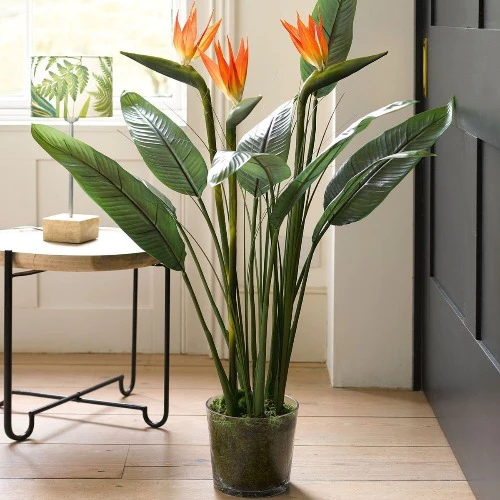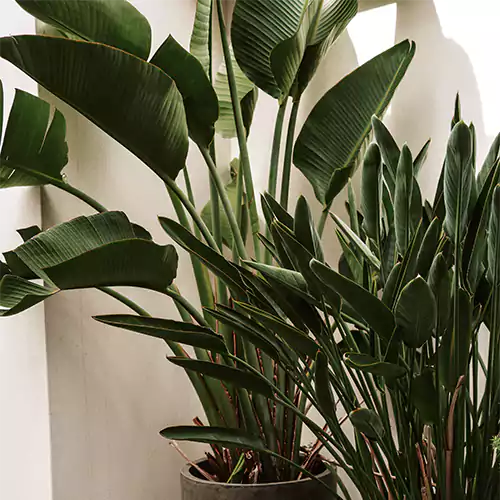Bird-of-Paradise Plant

One of the most well-known flowers in the world is the bird-of-paradise. It is the national flower of Portugal, yet it is originally from the subtropical coastal areas of southern Africa. It has been cultivated all over the world and has become naturalized in North, Central, and South America. Horticulturists, designers, florists, and gardeners all love its unusual and colorful blossoms because they resemble the head of a bird. When in full bloom, a bird-of-paradise can resemble numerous birds peering out from behind a clump of leaves, their elongated necks craning in all directions as their feathered heads and beaks point.
Characteristics
a flower is commonly known as a “bird of paradise” because of its vivid orange color
Flowers
The blossoms of the bird-of-paradise plant are the species’ claim to fame. The blooms, which sit atop stalks as tall as five feet, are intricate in structure and design, with vivid colors and abundant nectar to attract birds. The flower’s petals, stamens, and conspicuous stigma emerge from within a sheath that forms at the base of the stem and takes the appearance of a green, red, or purple canoe-shaped bract (a modified leaf, sometimes called a spathe). In most cases, the flowering season lasts from September to May.
Bird-of-paradise hummingbird sipping nectar
Nectar can be found in a “nectary” formed where two petals meet at the bottom of a flower, which is why birds visit flowers in the first place. In this scenario, a bird hops onto the smaller, lower petal, where its weight exposes the anthers, which then brush pollen across the bird’s feet and chest. The bird hops to another flower, lands on the stigma (which is large and sticky) to deposit pollen, and then hops in for more nectar. While many species of birds serve as pollinators, it has been shown that other species, such as sunbirds, are actually “nectar robbers,” meaning they only visit the bloom for the nectar.
Leaves
A bird-of-paradise plant has thick, waxy, evergreen foliage that forms a fan shape. The leaves might be a lustrous dark green, a bluish green, or a drab silvery hue. The leaves are paddle-shaped, like those of the banana plant, and grow on a tall, erect stalk. The mature plants of the narrow-leaved bird-of-paradise, on the other hand, have leaves that seem like pointed spikes.
Buy Now: 2-layer bamboo plant in Bangalore
Uses
The bird-of-paradise is a popular decorative landscape plant due to its durability, ease of care, and widespread use in tropical areas. In temperate climates, you can bring them indoors to flourish. Because of their exotic appearance and long vase life (up to two weeks! ), the flowers are a florist mainstay for tropical and exotic arrangements.
A Part Of Our Assortment
Paradise birds may usually be seen in the wild.
Bird-Of-Paradise
The most well-known species of bird-of-paradise features flowers with a dazzling array of hues, including blue lower petals, dark green spathes, and an upright fan of vibrant orange upper sepals. These flowers are commonly referred to as crane flowers in their native South Africa due to their resemblance to the crested bird’s head. In Africa, weaver birds are responsible for pollinating plants, while in the United States, the yellow-breasted warbler is one of the primary pollinators.
Colossal Birds-Of-Paradise Blossoms
As compared to Strelitzia reginae, this plant is substantially taller, with well-established specimens reaching heights of up to 30 feet thanks to their massive clusters of stems. It has unique blooms as well; the bracts, which surround the flower, are a dark purplish black color, while the sepals at the flower’s center are white or pale pink, and the flower’s “tongue” of petals is a bright, sky blue. The spathes of these flowers have a double-layer structure because one grows out of the other. The flowers generate a large amount of nectar from early spring to late summer, drawing in sunbirds in their native Africa and orioles in the United States.
A Bird-Of-Paradise With Narrow Leaves.
Among bird-of-paradise species, this one can endure dry conditions the best. It’s a beautiful accent plant because of its narrow, reed-like leaves and its clumping growth habit. Slightly little in comparison to Strelitzia reginae, these flowers are yet the same vibrant purple.
Strelitzia juncea is classified as Vulnerable in Africa because it is only found in six areas along the Eastern Cape and is threatened by quarrying and industrial development, illegal collection for the horticulture trade, and invasive plants. Additionally, the plant’s future is in jeopardy due to the lack of seed production and the decrease in the number of natural avian pollinators.
Whether you’ve saved your seeds or bought them, if the seed coat is tough, you can speed up germination by soaking the seeds in lukewarm water for a day or two and then nicking the coat with a little file or knife. Scarification describes this method.
After the seeds have been soaked, remove the bright orange tuft of hairs.
Plant the seeds in a pot or planting tray filled with a wet, sterile, and loose seed starting medium at a depth of 1/2 to 1 inch. Cover with a plastic bag or a humidity dome to keep the air moist.
Bottom heat of 75–90°F will aid in germination but is not required.
When stored in a moist environment, scarified seeds usually germinate within one to three months.
Professors in the Environmental Horticulture Department at the University of Florida IFAS Extension, Sydney Park Brown and Robert J. Black, say that storing seeds in a plastic bag in the refrigerator for two weeks at 40 to 45 degrees Fahrenheit can help speed up the germination process. The next step is to scarify them.
After the seedlings have three or four genuine leaves, they can be moved to six-inch pots.
Maintain a consistent moistness in the soil without allowing it to get soggy until the seedlings reach a height of six to eight inches.
Successful Expansion Techniques

Zones 9–12 are ideal for this plant, despite its origins in the subtropical coastline of South Africa.
Although in subtropical settings like Florida, partial shade is fine for birds of paradise, they do best in full sun.
The plants’ appearance will change depending on how much sunlight they get.
Flowers on full-sun plants tend to be smaller, while those in partial shade may grow a bit higher and wider.
A hole should be dug in the garden that is two to three times as wide as the root ball and as deep as the root ball is tall. The plant should be thoroughly soaked in water before being carefully removed from its container.
Don’t mess with the roots too much, as they’re easily injured when the plants are young.
After the hole has been dug, place the plant within it so that the top of the root ball is flush with the surrounding soil. Put the soil back in the well and fill it with water.
Flowers on a bird-of-paradise plant could not open right away if it’s planted too deeply.
Making a saucer-like basin around the plant will help it retain water until it can percolate down to the roots.
In the first six months following planting, keep the plant well-watered. When the top inch of soil feels dry when you touch it, it’s time to give it a good soaking.
Environment and Climate Requirements
The soil conditions in which a bird of paradise plant can thrive are quite flexible.
However, they thrive in organically rich, loamy soil with good drainage and a pH range of 5.5-7.5.
The plants have a brief tolerance to temperatures as low as 24 degrees Fahrenheit, but temperatures below freezing will kill off any buds or blooms that have yet to open.
Cover your plants if a harsh freeze is predicted, or move pots indoors when the weather becomes cold if you live in a region that frequently has freezing temperatures.
The article explains how to overwinter your bird of paradise plants and how to bring them inside for the winter.
Mulching and Irrigating
The leaves of this plant will turn yellow and finally die if it receives either too much or too little water.
Mature plants require watering only when the top three inches of soil are completely dry. They can’t stand having their feet in the water, and saturated soil kills roots.
If there is enough precipitation throughout the course of the winter, you might not need to water your plants at all.
Mulch the ground around the plant with a depth of two to three inches. This method will help to retain moisture, lessen the spread of weeds, and supply essential micronutrients.
Mulch should not be piled up against a plant’s stem. To prevent stem rot, leave a 2-3 inch diameter space around your plants clear of mulch.
Wood chips, bark, pine needles, and leaves are all great examples of organic mulches that can be used, but crushed stone or gravel is a better option in windy places.
Fertilization
These plants can survive in the garden without any additional fertilizer, but they will grow and bloom much more beautifully if you give them a balanced fertilizer.
Granular landscape fertilizers or controlled-release fertilizers like Osmocote (available on Amazon) are also effective. Other good options include well-rotted manure, worm castings, and blood meal.
Every three months during the growing season, apply as directed on the packet to a mature clump.
Fertilize container-grown plants every two weeks with liquid fertilizer or every two to three months with slow-release pellets.
Suggestions for Cultivation
Put your plants in a spot that gets at least some sunlight.
Soil that is both organically rich and well-drained should be provided.
If the top three inches of soil are dry, mature plants need good soaking.
Upkeep and Trimming
Taking care of these plants isn’t that difficult.
Dead leaves and spent flower stems should be pruned regularly to prevent fungal growth.
Expired flower stems should be lopped off at the base of the plant, just above the earth. Remove fading or dead leaves by snipping them off at the stem.
They will stay attached to the plant permanently unless you trim them off.
If you want more air to circulate in a room that has a lot of plants clumped together, you can thin off the foliage from the middle of the clump.
Regular Paradise Bird
- Regina’s orange and blue flowers, which are well-known and appreciated all over the world, make for a striking addition to any garden.
Paradise Bird (S. reginae)
On Amazon, you can buy plants in one-gallon containers that will grow to be one to two feet tall.
Giant
Do not confuse this species with the usual bird of paradise and put it in front of a window, as it can grow to a height of 20 feet and a width of 5 to 6 feet.
The Gold of Nelson Mandela
As its name suggests, S. reginae ‘Mandela’s Gold is a South African cultivar. In 1994, it was released thanks to the efforts of John Winter at the Kirstenbosch National Botanical Garden in Cape Town.
Originally marketed under the name “Kirstenbosch Gold,” in 1996, the name was changed to recognize Nelson Mandela.
The tongue of the flower is blue, and the petals are a vivid yellow. Plants often reach a height of four or five feet and a width of the same at maturity.
Here you may find out more information on the various species of bird-of-paradise plants.
Controlling Diseases and Pests
Although bird-of-paradise plants are mostly free of pests and diseases, there are unfortunately exceptions.
While pests and pathogens may cause damage to specific parts of a plant (such as a single bloom or leaf), they rarely pose a serious threat to the plant as a whole.
Aphids, scales, snails, grasshoppers, and caterpillars are some of the insects that may occasionally graze on the plants, although they are usually not a major issue. Systemic pesticides or snail bait can be used to get rid of them.
Leaves are susceptible to infestation by mealybugs and spider mites. To remove them, simply use a damp towel. Organic pesticides, such as neem oil, are also available for use in the treatment of pest problems.
This species of crown borer is known as Opogona.
Opogona omoscopa moth larvae eat their way into plant crowns, causing the leaves to droop and eventually fall off before the plant dies. There is consensus amongst experts that these pests are secondary pests drawn to the decomposing matter.
Good cultural care can ward off this form of infestation. Do not overwater your plants and remove any decaying or dead foliage that could be attracting moths.
While other species of whitefly affect plants, the giant whitefly (Aleurodicus dugesii) is a major problem for birds of paradise.
Not only does this insect drain the plant of its important nutrients, but it also produces a sugary secretion called honeydew, which can attract large numbers of ants.
To successfully eradicate this pest, early discovery is crucial. If the whiteflies are caught in the act early enough, you can spray the plants with water from the hose to kill them.
Get rid of the diseased leaves if your plants are severely infested.
Disease
Sometimes, bird of paradise plants falls prey to a bacterial infection and a few different kinds of fungi.
Damage to Roots Caused by Armillaria
All members of the genus Strelitzia are susceptible to this terrible disease.
Leaf discoloration is a sign of Armillaria. At the plant’s foundation, clusters of what are usually called “honey mushrooms” will develop over time.
There is now no treatment available, and fungal colonies can persist for thousands of years without dying out. If your plant develops this illness, it must be destroyed.
Good irrigation, adequate care, and enough drainage are all preventative measures.
Death by Bacteria

Bird of paradise plants may become infected with the common bacterium Pseudomonas solanacearum through their roots. This bacterium can survive in the soil for more than six years.
Furthermore, infected gardening implements, plant remnants, soil, insects, and water can all spread the disease.
Dying and yellowing of the leaves are the first symptoms of infection. Then, the plant’s bottom will start to turn black or brown near the ground.
Infested plants should be destroyed immediately to stop the spread of illness.
Leaf Spot, Caused by a Fungus
This infection, which can be caused by several different types of fungal infections, is not typically a major issue for a bird of paradise plant.
Infected leaves often have spots or patches of different colors, including black, tan, brown, and yellow. They could wilt and fall off the plant.
The majority of bird-of-paradise plants are immune to this fungus. The above illustration of this illness, in reality, shows a seemingly healthy plant.
In most cases, a fungal leaf spot infection can be contained by practicing excellent cultural care and cleanliness. It is recommended to treat plants with neem oil every 10-14 days.
Mold, Gray
Botrytis cinerea, the grey mold that causes rot in strawberries and other plants, is also known as botrytis blight.
The common term for the disease comes from the grey film that appears on infected flowers and leaves. The leaves will wilt, rot, and fall off the plant in due time.
The removal of dead plant matter and decaying detritus is an important preventative measure. Don’t water from above, either.
Some fungicides may work, but this particular fungus is known for rapidly gaining resistance, often within the first season of treatment.
A bio fungicide, such as Cease, may be effective in preventing and treating this illness. Arbico Organics sells a product with a Bacillus subtilis strain in it.
If you have a significant illness, you can spray your plants every three days instead of only once a week.
Damping Off/Root Rot A fungal pathogen can reside in bird-of-paradise seeds and cause damping off/root rot.
If you soak your seeds in room temperature water for 24 hours, you can avoid this problem. Rinse the seeds under cold water to remove any debris, then soak them in water heated to 135 degrees for 30 minutes.
Plant them in fresh soil when they’ve had time to cool and dry.
Learn more about diagnosing and treating illnesses in birds of paradise here.
Potentially Useful Applications
These blossoms can be found in most flower markets.
The plants can be used as a focal point in a garden or as an attractive houseplant, particularly in a sunroom, in colder climates. Having a giant perennial with beautiful blooms in your yard is nice, but that’s not all they offer.
Leaves from a bird of paradise plant do not fall off and remain on the plant year-round. This makes them a great option for landscaping around pools, where leaves can become an issue.
Online Order: Special 3-layer bamboo plant
